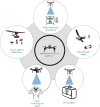Monitoring System-Based Flying IoT in Public Health and Sports Using Ant-Enabled Energy-Aware Routing
- PMID: 34306586
- PMCID: PMC8270719
- DOI: 10.1155/2021/1686946
Monitoring System-Based Flying IoT in Public Health and Sports Using Ant-Enabled Energy-Aware Routing
Retraction in
-
Retracted: Monitoring System-Based Flying IoT in Public Health and Sports Using Ant-Enabled Energy-Aware Routing.J Healthc Eng. 2023 May 24;2023:9813405. doi: 10.1155/2023/9813405. eCollection 2023. J Healthc Eng. 2023. PMID: 37266281 Free PMC article.
Abstract
In recent decades, the Internet of flying networks has made significant progress. Several aerial vehicles communicate with one another to form flying ad hoc networks. Unmanned aerial vehicles perform a wide range of tasks that make life easier for humans. However, due to the high frequency of mobile flying vehicles, network problems such as packet loss, latency, and perhaps disrupted channel links arise, affecting data delivery. The use of UAV-enabled IoT in sports has changed the dynamics of tracking and working on player safety. WBAN can be merged with aerial vehicles to collect data regarding health and transfer it to a base station. Furthermore, the unbalanced energy usage of flying things will result in earlier mission failure and a rapid decline in network lifespan. This study describes the use of each UAV's residual energy level to ensure a high level of safety using an ant-based routing technique called AntHocNet. In health care, the use of IoT-assisted aerial vehicles would increase operational performance, surveillance, and automation optimization to provide a smart application of flying IoT. Apart from that, aerial vehicles can be used in remote communication for treatment, medical equipment distribution, and telementoring. While comparing routing algorithms, simulation findings indicate that the proposed ant-based routing protocol is optimal.
Copyright © 2021 Inam Ullah Khan et al.
Conflict of interest statement
The authors declare that they have no conflicts of interest.
Figures












References
-
- Sun J., Khan F., Li J., Alshehri M. D., Ryan A., Wedyan M. Mutual authentication scheme for ensuring a secure device-to-server communication in the internet of medical things. IEEE Internet of Things Journal. 2021 doi: 10.1109/JIOT.2021.3078702.3078702 - DOI
-
- Abul Hassan M., Irfan Ullah S., Salam A., et al. Energy efficient hierarchical based fish eye state routing protocol for flying ad-hoc networks. Indonesian Journal of Electrical Engineering and Computer Science. 2021;21(1):465–471. doi: 10.11591/ijeecs.v21.i1.pp465-471. - DOI
-
- Alsamhi S., Ma O., Ansari M., Gupta S. Collaboration of drone and internet of public safety things in smart cities: an overview of qos and network performance optimization. Drones. 2019;3(1):p. 13. doi: 10.3390/drones3010013. - DOI
-
- Rezwan S., Choi W. A survey on applications of reinforcement learning in flying ad-hoc networks. Electronics. 2021;10(4):p. 449. doi: 10.3390/electronics10040449. - DOI
-
- Jan S. R., Khan R., Khan F., Ahmad Jan M. Marginal and average weight- enabled data aggregation mechanism for the resource-constrained networks. Elsevier Computer Communication Journal. 2021;174:101–108. doi: 10.1016/j.comcom.2021.04.004. IF 2.81. - DOI
Publication types
MeSH terms
LinkOut - more resources
Full Text Sources

